Pre-employment skills testing is like giving your HR team a time machine. These tests create a window into a candidate’s future within a business, providing reliable insight into how they’ll perform on the job, fit into the company culture, and interact with others.
With an accurate picture of candidates’ skills — your team can avoid spending up to $16,999 in turnover costs with the wrong fit!
In this article, we explore:
Quick Links:
- What is pre-employment testing?
- The advantages and disadvantages of pre-employment tests
- 4 pre-employment assessment categories
- How to choose the best test assessment types
- How applicants benefit from pre-employment assessments
What is pre-employment testing?
Pre-employment testing refers to the type of tests that a candidate performs before they’re hired for a role. It’s a standardized way to test candidates on their skills, experience, and potential fit as an indicator of future job performance.
Organizations use these tests to get a clearer picture of the level of a candidate’s knowledge, aptitude, and skills relative to the role they’re applying for. Unlike CVs and short interviews, these assessment tools provide in-depth insight into how well a candidate is suited to a particular role, and the organization as a whole.
Pre-employment testing is a more modern way to screen candidates. Since the whole process can occur online, it speeds up the recruitment process, and enables data-driven hiring and smarter HR decisions.
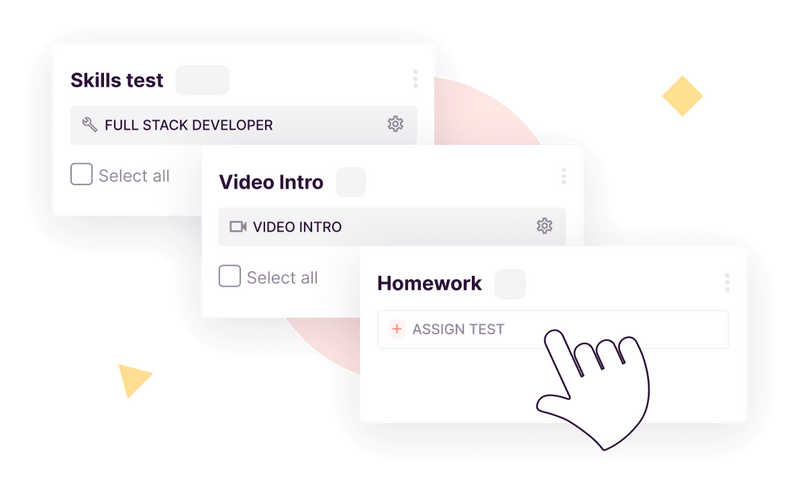
Here’s an example of hiring with pre-employment testing
Picture an international company that operates remotely, like a content marketing agency. If they want to hire a new writer, they can now automate most of the selection process.
- To begin, they’ll establish if a candidate has the right soft and hard skills necessary through an online pre-employment test. Then they’ll only have a handful of relevant candidates to interview, saving the hiring team valuable time.
- Instead of jumping into face-to-face meetings right away, the hiring process will include an asynchronous video interview to screen for critical skills, such as critical thinking and communication, early on. Only the best-fit candidates will speak with the hiring managers.
- Once the technical and cultural fit is confirmed, the shortlisted candidates will move on to a 2-hour homework assignment. As a real-life skills assessment, the take-home task will help companies evaluate candidates’ practical knowledge and predict job performance. With proof of competence, making the right hiring decision will be easy.
Bet you can see why these assessments are popular with remote companies, high-growth startups, and Fortune 500 companies! We’ve hired 150+ incredible talents around the world using this hiring process.
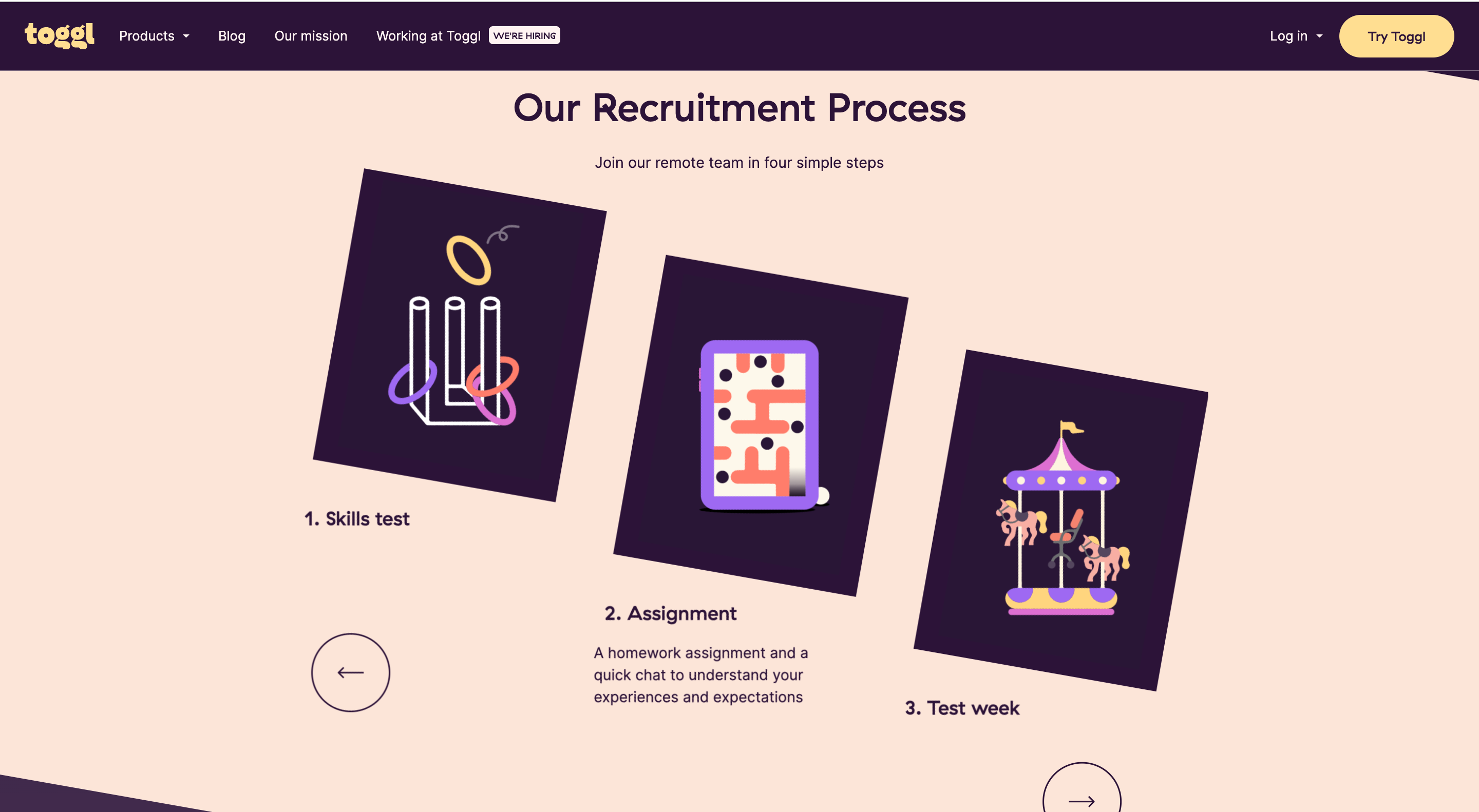
What are the advantages of pre-employment testing
These assessments are exactly what your recruitment team needs to filter the gold from the sand in your hiring stream. With a qualified way of sifting through multiple candidates, you’ll be rewarded with benefits like:
- A streamlined hiring process — pre-employment assessments help recruiters automatically sift out the candidates that don’t have the right skills for the role.
- Increasing employee retention rates and reducing the cost of bad hires or turnover costs by raising the likelihood of both a solid fit and stronger job performance.
- Data-driven hiring decisions — reduce bias and ensure your hiring is equitable by basing your selection on candidate skills and experience (not braggy CVs).
- More context on potential employees — skills tests help you see more sides of the candidate, a bit like a 2D image vs a 3D model. You get a better idea of how the candidate’s experience and skills match up to the job description.
- Improved candidate interviews — you can discuss findings from their tests during interviews to reveal more about how they work or think.
- Using skills test data to create an onboarding training plan or career development plan for the successful candidate.
- Higher levels of productivity — for the HR team with standardized candidate testing. Plus for the candidate, as HR is choosing people that are the right fit for the role and team leading to better synergy and productivity.
And the disadvantages of pre-employment testing?
Luckily, you’ll find the list of cons for pre-employment assessments is pretty short. And that’s not surprising. Today’s businesses need modern, digital workflows for hooking the right talent.
- Some candidates may find these tests off-putting (especially if they’ve applied for numerous roles and performed numerous tests). So, make sure your tests are relevant to the position and the appropriate length for the hiring stage. For instance, using a two-hour homework assignment as an initial screening test will definitely scare off most applicants.
- The cost of administering pre-employment tests — yet another hiring cost? Perhaps the real question is whether your team can afford not to modernize screening and selecting candidates that are a good fit.
- Candidates could cheat by having someone else complete the test for them — these days, most platforms include anti-cheating mechanisms that prevent this.
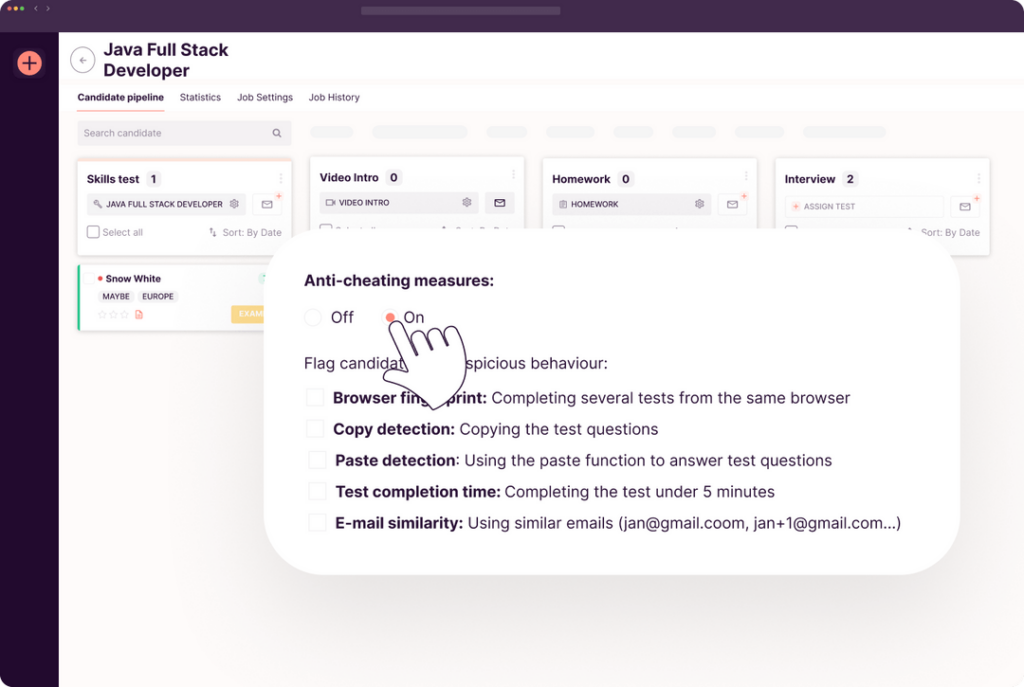
Are there different types of pre-employment testing?
Yes. Pre-employment tests come in many different shapes and sizes. You can break down the core category into soft skills, such as level of integrity or communication skills, and hard skills, such as coding or UX Design.
What’s interesting is that even background checks, physical ability, language tests, and drug tests are considered pre-employment tests. But this is in the very broad sense of the definition — as any kind of test that happens before someone is employed.
Exploring the most common pre-employment test categories
Recruiters use a variety of assessment tests to establish an applicant’s proficiency in all the components of the job spec.
The five main categories include:
- Skills tests
- Cognitive ability tests
- Personality assessments
- Emotional intelligence tests
- Risk tests
Let’s explore each one so you can perfect your hiring process (and knock the socks off your hiring manager).
#1 – Skills assessment tests
Pre-employment skills tests assess the candidate on their ability to perform the job they are applying for. These job knowledge tests focus on the technical knowledge, expertise, and general aptitude needed for a particular role. And are fast becoming a staple in the world of recruitment.
For example, skills assessments may test a software engineer’s knowledge of a particular coding language or test a digital marketer on the latest SEO best practices. Skills tests are great for testing soft skills, too, allowing you to gauge a candidate’s communication, creativity, and leadership skills.
At Toggl Hire, skills testing is our Thing. Our all-in-one skills assessment platform helps recruiters create a seamless hiring workflow. You can choose from a range of prebuilt assessment templates based on a particular skill set or role, and start filtering out top candidates for your hiring pipeline immediately.
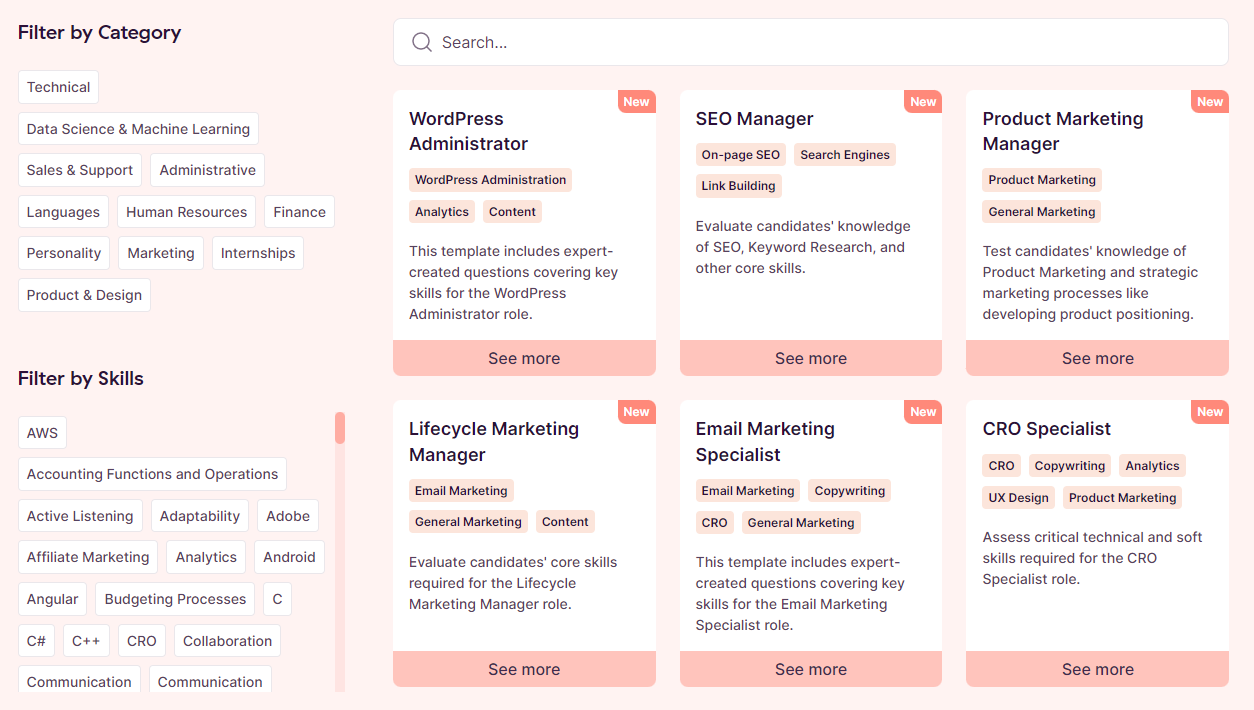
#2 – Cognitive ability tests
Cognitive ability tests (also called aptitude or IQ tests) measure a person’s ability to think, learn, reason and apply information. These tests can measure specific abilities like:
- Critical thinking
- Numerical reasoning
- Verbal reasoning
- Logical reasoning
- Mechanical reasoning
Aptitude tests help recruiters learn more about a candidate’s strengths and weaknesses, and are often used in screening for mid to senior level roles. These tests could be particularly helpful for technical appointments like engineers or where high-level problem solving is needed like a project manager.
[Fun fact: pre-hiring tests have been around since as far back as the Han dynasty — in the 3rd century — and was used for choosing suitable civil servants!]
#3 – Personality tests
Personality tests assess a person’s long-term behavioral traits. HR managers can use this information to determine if the candidate’s personality or behavioral tendencies fit well for a particular role, and with the company culture.
One of the most common test frameworks is the Big Five model, which assesses five core traits — extroversion, openness, agreeableness, neuroticism and conscientiousness. Other popular personality tests include the Caliper Profile and Myers-Briggs.
Personality or behavioral assessments are useful when recruiting for customer service, sales, or other customer-facing roles, which require specific personality traits, such as assertiveness and confidence.
TIPPersonality tests are most effective when combined with another type of testing, like a skills test. Psychometric testing, for example, covers both of these categories.
#4 – Emotional intelligence tests
Emotional intelligence or EQ is still the new kid on the block in the world of job suitability.
Emotional intelligence is the ability to use, understand and manage one’s own emotions in a positive way, and to manage stress, communicate effectively, de-escalate issues, problem solve, and empathize with other people.
Source
Test takers and employees that have a high EQ may have the same knowledge and experience, but they stand out from their cohort in their ability to manage their emotions and be more perceptive and understanding of emotional situations in the workplace, like a highly stressful project. Their EQ has a positive effect — understanding others emotions in the moment, and helping everyone work together and focus on the overall goal rather than any personal issues.
Testing EQ for leadership or HR roles, where a person’s ability to intuit and understand emotions, can be a key success factor.
#5 – Risk tests
Risk tests are types of tests that help an organization reduce risk and maintain the health and safety of its employees.
A few types of risk tests you may have encountered include:
- Integrity tests — tests how likely a candidate is to follow the company’s rules and roots out any counterproductive tendencies, like absenteeism or safety violations. These tests are often used for entry-level positions to ensure potential employees will take responsibility for completing their tasks and do so efficiently.
- Safety assessment — looks at how likely a candidate is to behave in a way that creates or heightens the risk for themselves or their coworkers.
- Physical ability tests — determine if a person meets the physical requirements of a job. This is particularly relevant for very physical work like jobs in security or firefighting, for instance.
Tip! Background checks are also a form of risk test, but they can be very costly. Luckily, integrity tests can be an even more effective solution as they often uncover a broader range of unproductive or unethical behaviors.
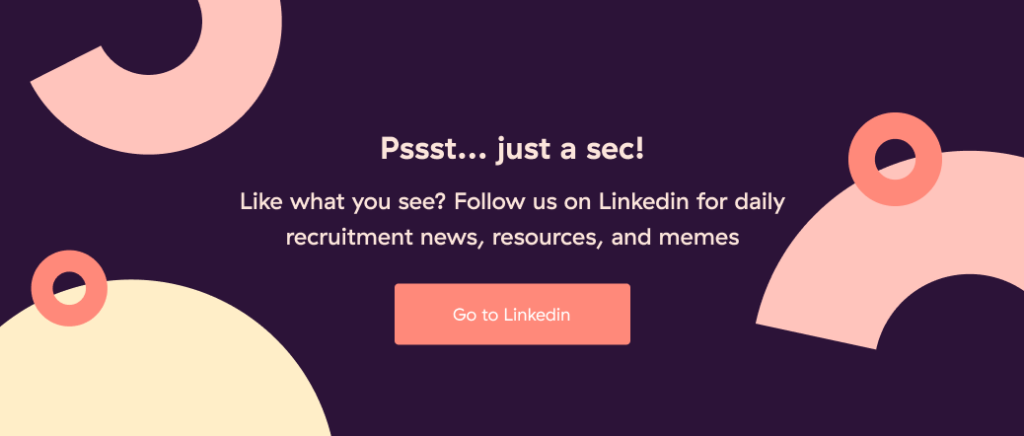
Which type of pre-employment assessment test should I use?
Pre-employment assessment tests work best when you use a combination of them. And your selection of tests will depend on the role you’re recruiting for. Cognitive ability may be key for one role, while specific job knowledge is essential for another.
An example of a testing mix for a senior role
Let’s say you need to recruit a senior software engineer. Once you’ve established the details of the role, you then decide what tests would work best to find the right candidates. You’ll need tests that will demonstrate the candidate’s level of technical knowledge and experience match up with a senior-level role.
A good mix of tests could include: a skills test (to test their technical developer capabilities or programming skills), a cognitive ability test (to test their critical thinking skills), and a structured interview (to check their communication and problem-solving skills).
What if you’re testing for a junior role?
Okay, let’s look at another example. Your organization’s marketing department is growing fast, and they’ve said they really need to hire a marketing assistant. Once you’ve agreed on the job specs, you can decide what tests are the most relevant.
Remember, you’re dealing with a junior role, and that could mean high volumes of applicants. You’ll definitely want to quickly narrow down the vast pool of candidates to those that actually qualify. Starting with a basic, short marketing skills assessment can help you whittle down the applicant pool in no time.
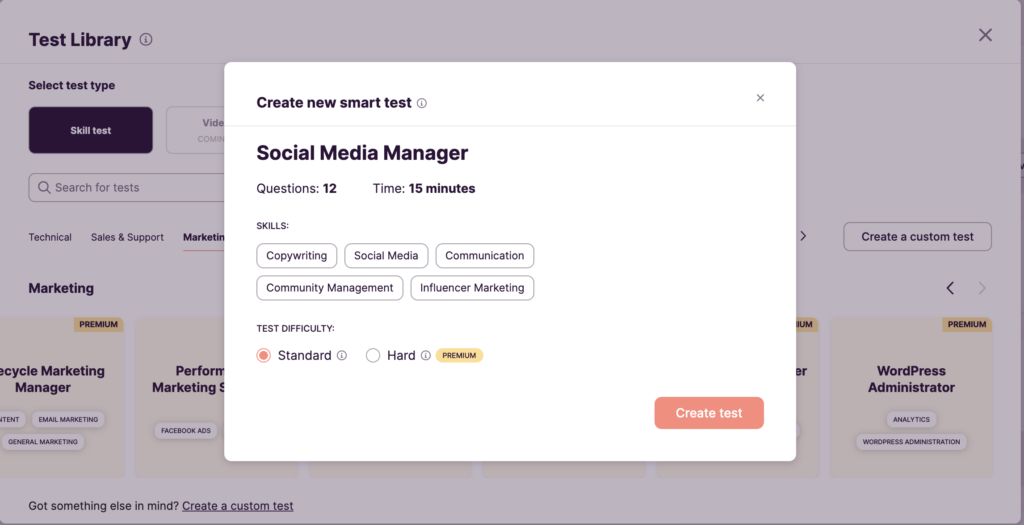
Next in the test lineup, you could add an asynchronous video interview — a pre-recorded video Q&A that candidates create, sharing more info about their skills, experiences, and knowledge.
Following that, you may choose to have candidates complete an integrity test – if that was a key parameter for the role or organization. But! A word of caution – only use pre-employment tests that are vital for the role.
If you have too many assessments or irrelevant tests prior to interviewing, you risk putting candidates off.
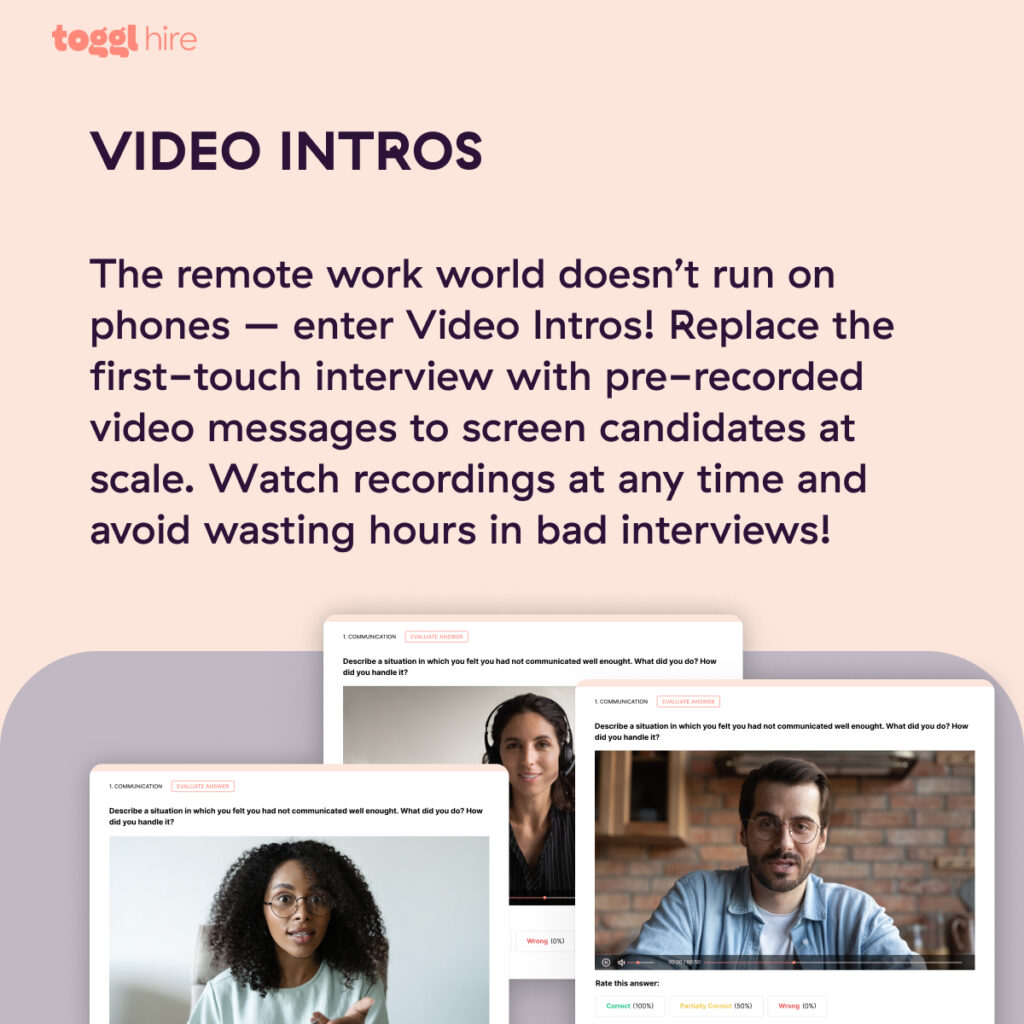
Best practices for using pre-employment assessments
Here are a few pointers to help hiring managers hit the right notes with their hiring decisions.
- Choose the right combo of tests for the role. Too many tests could scare off good candidates.
- Select the right type of assessment tool for the right stage in the recruitment funnel. For instance, a two-hour homework assignment as your first test will raise red flags for candidates (as they may feel like you’re trying to exploit them).
- Test early in the process to save time, saving more comprehensive testing for the last stages.
- Make sure the hiring team is familiar with the assessment tools you select for the role.
- Track the success of your testing methods so you can continually tweak and improve the applicant experience.
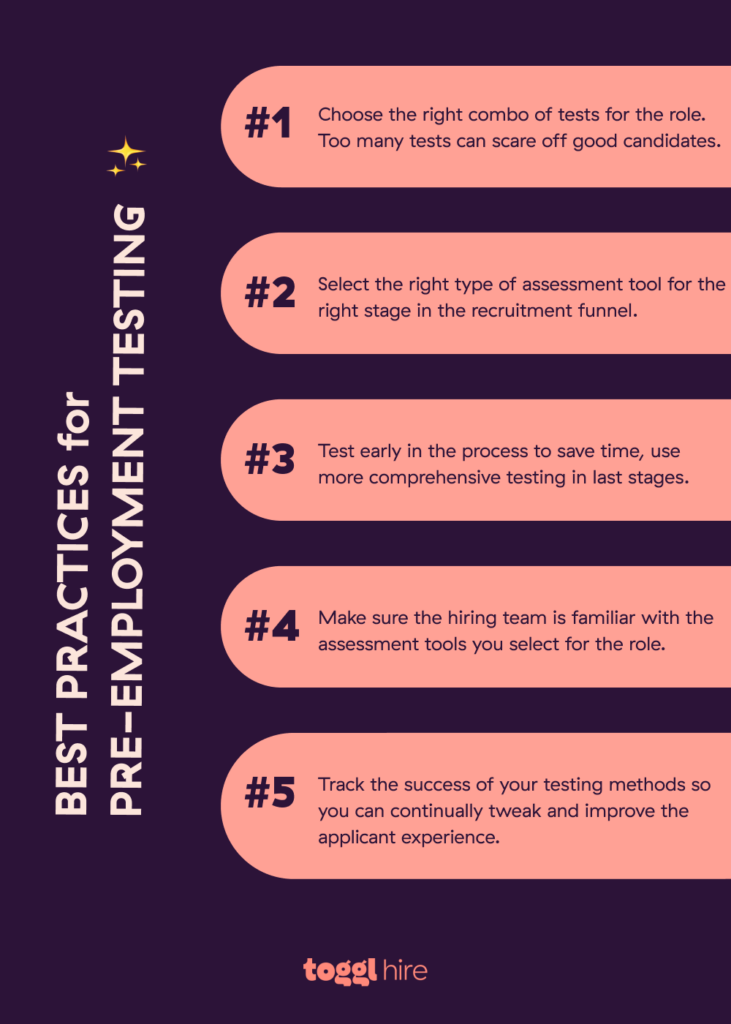
What do applicants get from taking pre-employment tests?
Since they’re spending a lot of their time and energy completing multiple tests, let’s take a look at what are some things an applicant can learn from taking a pre-employment test.
Spot any knowledge gaps
Pre-interview tests can help candidates spot any gaps in their knowledge. By knowing what’s typically expected from someone in their role, they can identify any areas they need to develop or strengthen.
Showcase their abilities
These tests are an opportunity for top candidates to showcase their skills and stand out from the rest of the job applicants.
Less likelihood of bias
Online assessments and job testing can help reduce or prevent bias in the hiring process. That way, someone with a different background, educational level or age, for instance, is not unfairly discriminated against.
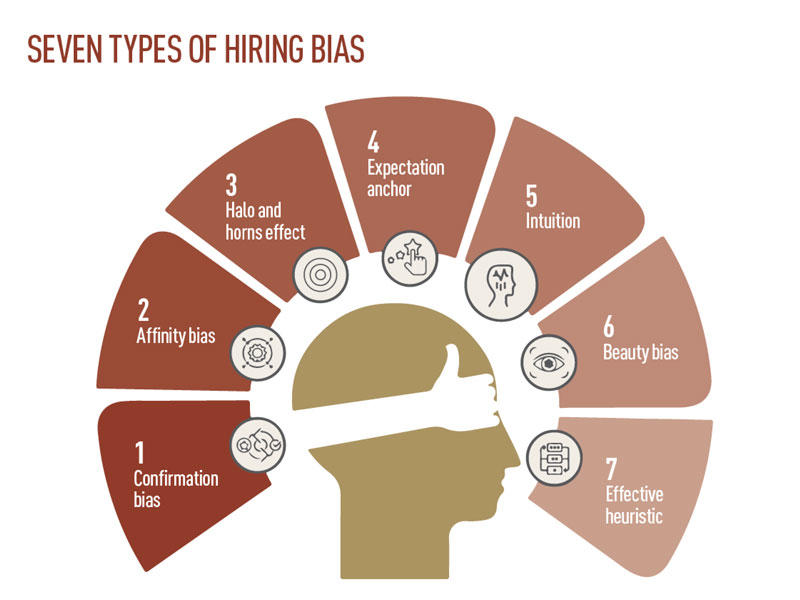
Hassle-free screening for companies and candidates with Toggl Hire’s skills assessment platform
While there is a plus side for candidates in completing pre-employment tests (like showcasing their abilities), companies can also make the process more fun (with gamification) and as seamless as possible by using a modern assessment platform.
Since it’s easy to apply for a role these days, organizations need the ability to pre-test the flood of applicants to determine who goes through to the next step in the recruitment process.
Whether it’s aptitude, skills, or personality testing, organizations use pre-employment tests to get a comprehensive view of each candidate — a glimpse into the future — and only take the best applicants forward.
Toggl Hire’s all-in-one skills assessment platform can help your team find and shortlist the right candidates fast. Faster than time travel? Well, we hope so! 😉
James Elliott is a Strategy Manager and Writer from London, UK. When not working on the day job, James writes on a variety of business and project management topics with a focus on content that enables readers to take action and improve their ways of working. You can check out James’ work on his website or by connecting on LinkedIn.






